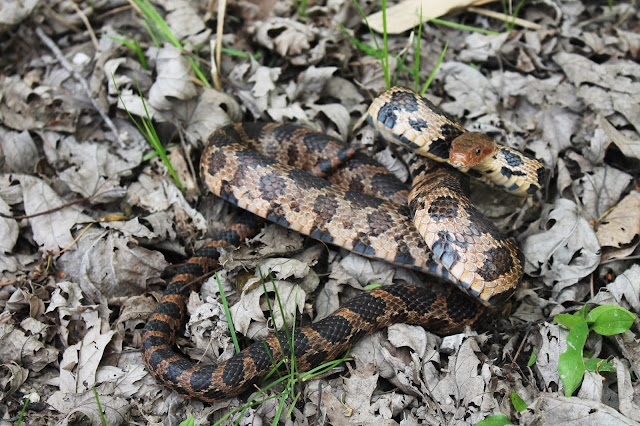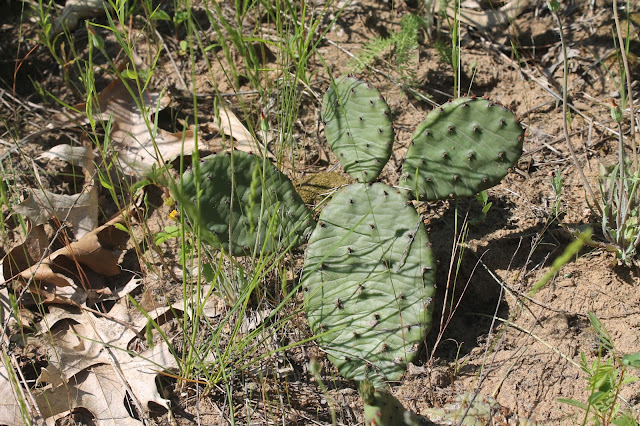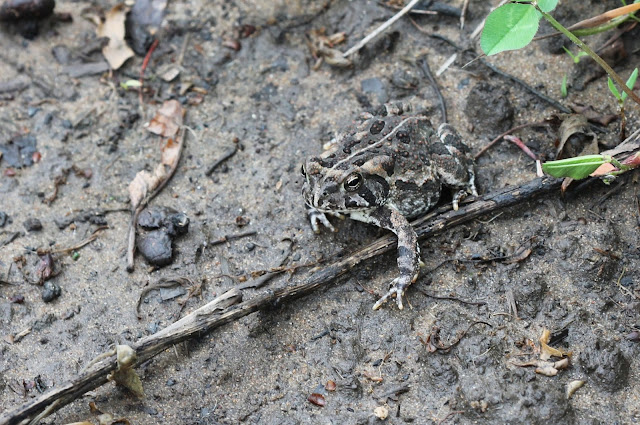First off, I began my research project into the herpetofauna of the DRCA this spring. After hearing reports of frogs calling a few years back, and being told of snake sightings (a "green snake" crawling through shrubs - can that description be any more uncharacteristic?), and finding two plains garters (Thamnophis radix) myself in 2013, I decided to organize my own season-long study of the species that call the DRCA home. I systematically laid out wood and metal coverboards in arrays of 2-4 throughout the site, labeled them as part of a research project, and have gone back to check on them and record data at least once a week since. The site has all the telltale signs of being Kirtland's snake (Clonophis kirtlandii) habitat, but of course that doesn't mean they are there; even if they do persist there, there is no guarantee they will be found this year. At season's end, I'll post the results of the project. Let's hope I have something to celebrate over!
In late April, and again in early May, I was part of a herp survey team headed by Tom Anton, to find and document unrecorded species in "a" county in western Illinois, along the Mississippi River. Since our finds haven't been published yet, I cannot name the county we worked in, but I'll share a few photos and stories anyway. I had a fantastic time, working with Tom, Tristan Schramer, Doug Mills, Yatin Kalki, and Sam Brolley. Most importantly, we walked out of there with FOUR county records, including one for which I found a dead-in-field (DIF) voucher specimen. Overall, seventeen species of herps were found. We also found a friendly stray dog, locals curious as to what we were doing (and threatening to call the police), and a new respect for buffalo-bur (Solanum rostratum) seedpods (big-time OUCH when you're kneeling on them in the sand to get a shot of a flighty lizard).
Some good advice - always wear a hat. They work wonders for calming and situating snakes for photos.
The subject - this beautiful western ribbon snake (Thamnophis proximus)
Something I don't see very often at all, the plains leopard frog (Lithobates blari).
Northern water snakes (Nerodia sipedon) were very common and frequently encountered.
Tom with a neonate sipedon.
Some of the habitat we searched and had success in.
On to week two, where we were joined by the rest of the crew. Here we were on our way to a floodplain forest via long-abandoned railroad embankment.
Tom and Tristan scheming.
Doug Mills photographing a northern water snake. This particular snake was the same exact animal I saw the week prior. We had scared it off the bank and into the river. This time, I slowly crept up to it on my belly and grabbed it before it even saw me coming!
A neonate western fox snake (Pantherophis vulpina) found by one of the other guys.
This northern leopard frog (Lithobates pipiens) gave Tristan and I a workout trying to catch it. We finally got it and took a few shots.
A running joke surrounded the large number of duck decoys we saw around a floodplain. I posed this northern water snake next to one of them for Tom.
This female is the counterpart to the male posed next to the decoy above - they were found together under a log near the floodplain.
Tom with the female, displaying the beautiful ventral scales.
I don't get lizards in Chicago, so it's a treat to see them whenever the opportunity presents itself. Here is a six-lined racerunner (Aspidoscelis sexlineata) that Sam skillfully caught by hand.
A gorgeous eastern garter snake (Thamnophis sirtalis), looking a lot like the ones found right across the river in Iowa. With all that red, this freshly-shed sirtalis was a highlight.
Tristan prepping the garter for photos.
Sandy habitat along the river.
Shortly before releasing the racerunner.
We hopped to the final spot of the day, an extensive patchwork of wetlands and backwaters of the Mississippi that bordered farm fields. This eastern garter was found on a road separating the farm field from the wetlands, doing its best impression of a cobra.
At one point while all five of us were surveying the wetlands from the road, Sam shouted from the rear that he heard a rattling sound coming from inside a big mass of dried reeds on the side of the road. We ran toward him, and I reached around until I felt and pulled out a defensive fox snake.
Tristan with the fox.
It was getting late, and I guess the dogs were coming out. Stray dogs are a normal occurrence out in rural areas, but most don't run right up to you and allow you to pet them. This one was probably just looking for food. Unfortunately, we were unable to accommodate his needs.
Early May is American toad (Anaxyrus americanus) breeding season here in Chicago, and I was right there to document some of the explosive activity that occurs in ponds and backwaters in the area. I was joined by Jeff Skrentny, a local birder who is counting birds at the Trestle, my most local forest preserve.
I wish I can deliver sounds as I do photos on this blog. The sounds of hundreds of toads calling is one of the most beautiful sounds I know.
Jeff, with his expert birding eyes, spotted these screech owls high up in a tree. Here, you see an adult to the right, with two youngsters below and to the left. I would never have spotted these on my own.
Ridged carrion beetles (Oiceoptoma inaequale) feeding on the decomposing carcass of what I think is a squirrel. Very cool observation!
This one is exiting the orbital cavity. Yum.
Jeff helped me by calling and telling me the toads were out and doing their thing, so the least I could do was help him find his "lifer" midland brown snakes (Storeria dekayi wrightorum) and plains garters (Thamnophis radix).
Later in the month, I headed down to Will County, to some sand prairie/savanna habitat, followed by a jaunt through a dolomite prairie nearby. I am notoriously unsuccessful south of I-80 when it comes to reptiles and amphibians, so what success I had was mostly due to the aid of my partners - Matt and Shannon Bordeaux. We did not meet our goal at finding Matt an Eastern hognose snake (Heterodon platirhinos), but we did make a few interesting finds anyway, and had a good time.
Not much trumps a good powerline cut through sand country...
It took teamwork to capture this sufficiently warmed and agile six-lined racerunner. Matt, Shannon, and I all convened from three different angles to catch this guy in tall dry grass, where they are best suited for evasion from predators.
A huge black oak (Quercus velutina) in, of all places, a black oak savanna.
Shannon spotted this crisp, powder-green eastern grey treefrog (Hyla versicolor), oddly enough, on a sun-lit patch of ground in the middle of the day.
Huggable eastern prickly pear cactus (Opuntia humifusa).
At the dolomite prairie. A dolomite prairie is essentially an area where the dolomite bedrock is closer to the surface than in surrounding areas. The soil here is probably a few feet deep max in most places, but in some areas there exists dolomite "pavement", where the bedrock is completely exposed with no soil on top. This view shows such dolomite pavement.
A dolomite prairie is very goof habitat for blue racers (Coluber constrictor foxii). Matt found this one under a flat rock.
Move over, Swiss Army knife - we've got a new multi-tool - my hat, again used as a "calming chamber" for snake photography.
Right next to the rock where the racer was uncovered, was another rock where Matt found this big Eastern garter (Thamnophis sirtalis).
Matt made a Steve Irwin-esque dash into a pond to grab this western painted turtle (Chrysemys picta bellii).
The funny thing about this outing was the ease by which we quickly found five queen snakes (Regina septemvittata). Not only that, but they were all found in a murky, stagnant ditch that has been cut off from its main branch by quite some distance, stranding the queens for the time being. Evidently, there are enough crayfish in the area to sustain them. I spent a good chunk of my free time last spring and summer looking for queen snakes (albeit in DuPage County), in a well-known stream famous for its queens; it was textbook habitat, and ultimately I did find one, but it was only after a lot of driving, hiking, slipping, mosquitoes, and territorial pit bulls. Here, I simply walk up to a rock in this muck, flip it, and grab at queens galore. No one ever said this was simple business.
Here's a shot of one of the queens, with habitat in the background. This was probably the best-looking stretch of the ditch, sadly.
Our path back to the cars.
And FINALLY, the last outing of the month, which occurred on the last day of May. A caravan of herpers - myself, Matt & Shannon Bordeaux, and Sean & Toni Childers made a day out of K3 - the sand region of Kankakee & Iroquois Counties, IL. I was last out here in the summer of 2013. I went with Jeffrey Peffers and we largely came up empty. The truth is, is that you cannot expect to find a lot of snakes in the preserves in K3. The most productive sites are off the preserves, on public (or sometimes, on unmarked private) land. The reason for this is simple. K3 is an extremely poverty-stricken rural area. A lot of the structures that once stood - houses, sheds, utility buildings - are in ruins. And this material is highly sought-after by snakes to use as cover. There seems to be a disconnect between the people who live there and government. In all of my trips there, I've never once seen an official government vehicle. No police, postal service, nothing. In fact, you'll rarely see vehicles of any kind, aside from the ones that have been dragged into the middle of sand prairies, flipped over, and abandoned.
A lot of unsavory things happen at K3. There are stories of meth labs, dog fighting, undocumented people living in shanties in the woods, and overall rampant crime. I believe it because I've seen much of it myself. Many of the residents are very warm, cheerful, and understanding when it comes to a bunch of out-of-towners coming in to look for snakes. All, however, remain cautious of our actions. Some of the residents want nothing to do with outsiders, and they've been known to threaten with guns. Fortunately, I haven't witnessed that. Poverty is long-ingrained in the culture of the region, as the sandy soil has always been unsuitable for agriculture. It's a sketchy predicament going there, but it's also one of the most biodiverse regions in the Midwest.
One of our stops was to this site. Artificial cover was in abundance, but so were cars and car parts laden in toxic chemicals. Batteries can leach toxins, and all matters of fluids eventually find their way into the ground. So, yeah, it looks like a cool scene from the Walking Dead, but in truth, it's not only a hazard to wildlife, but to the people who live and depend on the land.
What was once a big yellow school bus...
Near a dilapidated camper occupied by a man who once chased away outsiders while he was naked, we found this neonate eastern milk snake (Lampropeltis triangulum).
Very close to the little milk was this nice blue racer found coiled tightly underneath a small plastic oil jug.
While navigating a tick-filled meadow littered in trash, we saw a number of Fowler's toads (Anaxyrus fowleri).
Matt found this gorgeous adult milk snake, one of two adults seen.
No walk through an isolated field in the middle of K3 is complete without waves of Cannibus gently swaying in the early afternoon breeze.
The highlight of the trip occurred at the tail end. Our second adult milk snake was in Sean's hands. Sean's wife Toni wanted him to pose with it close to his face such that it appeared that the snake was about to bite him. Well, when you mess with the bull, you get the horns, as they say. The snake chomped down on his nose and proceeded to hang on for about two minutes before releasing its hold, all the while we were all laughing so hard that we (or maybe it was just me) were in tears. I needed something hilarious to counterbalance the sadness that I feel for the land as it continues experiencing abuse and neglect.
That's it for May! We'll see what June brings. Until next time...






































































